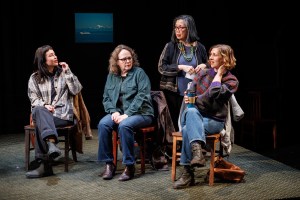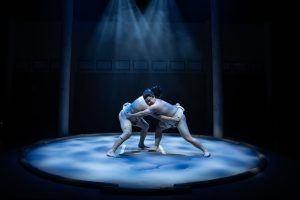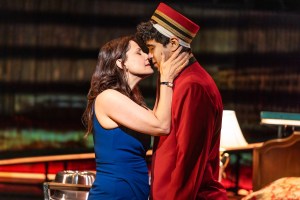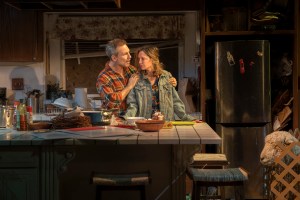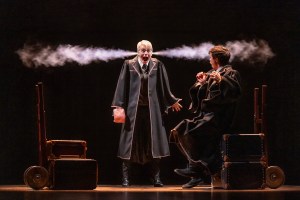Lady, Be Good!
Encores! presents a classic Gershwin score set against a forgettable and dated story.
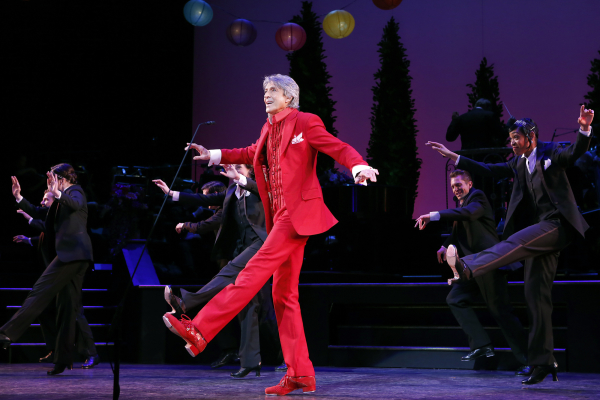
(© Carol Rosegg)
They sure don't write them like they used to, and perhaps that's all right. You might think so too after seeing the Encores! production of George and Ira Gershwin's 1924 musical Lady, Be Good! at New York City Center. That's not to say the show isn't delightful for many reasons, but a compelling script isn't one of them.
Written as a star vehicle for sibling dance sensations Fred and Adele Astaire, Lady, Be Good! was the first collaboration between the Gershwins to make it to Broadway. George Gershwin's music is gorgeous and unforgettable; Ira Gershwin's lyrics are witty and urbane; but the book (by Guy Bolton and Fred Thompson) for this musical comedy is mostly funny for its questionable taste and ludicrous contrivance.
It begins with brother-and-sister dance team Dick (Danny Gardner) and Susie Trevor (Patti Murin) on the skids, evicted from their apartment for not paying rent. They're so broke that the only way they can eat is by donning their eveningwear and pilfering hors d'oeuvres from fabulous Gold Coast soirees. Dick loves Shirley (Erin Mackey), but worries he'll have to settle for mean rich lady Josephine Vanderwater (Jennifer Laura Thompson). Meanwhile, at the behest of crooked lawyer Watty Watkins (the hilarious Douglas Sills) Susie agrees to impersonate the Mexican widow of millionaire Jack Robinson in order to gain access to his fortune. ("I hadda bella wedding inna da chapel in-a-da chuch-a" is one of her actual lines.) But while she's performing this crude minstrelsy, all she really wants to do is run away with a handsome hobo (Colin Donnell, Murin's real-life fiancé). As Fred Astaire wrote in his autobiography Steps in Time, "What the plot of Lady, Be Good! was I really can't remember, but I do know that it was pretty stupid."
Of course, like most pre-Show Boat Broadway musicals, the plot is ancillary: It's a way to kill time between the floats in the hit parade. And the score is filled with so many winning tunes. "Oh, Lady, Be Good!" infiltrates our brains throughout the night. "The Half of It, Dearie, Blues," has a frenetic urban energy. As performed by odd couple Jeff Hiller and Kirsten Wyatt, "We're Here Because" is the evening's funniest song, with a Cowardian flair.
In 1924, these were the kinds of songs you would expect to hear at a nightclub post-curtain. Conductor and music director Rob Fisher gives us an authentic taste of that era with his sizable orchestra (including nine violins!) and something completely unheard of in a modern Broadway musical: dueling grand pianos. It's the kind of opulence only Encores! can provide. Chris Fenwick and Greg Anthony skillfully step into the roles originated by Phil Ohman and Victor Arden, giving us a taste of Gershwin piano times two in the thrilling "Piano Specialty" musical interlude, which Fisher has created based on extensive research into the piano duo and Gershwin. (The original music was lost.)
One tune that has survived is the show's most popular: "Fascinating Rhythm." Nine-time Tony winner Tommy Tune appears out of nowhere to introduce us to this timeless number and taps us into a stupor. Tune is playing the role of jazz musician Jeff White, although he's billed in the program as "The Professor." This enigmatic new moniker, taken in concert with the bright red suit he wears in the first act and his complete dissociation from the story gives him a supernatural aura, like Mr. Applegate (the devil) from Damn Yankees. Truly, there is something hypnotic about his lithe movements and Cheshire grin.
But the evening's real showstopper turns out to be Gardner. Not only is he a dead ringer for Fred Astaire, his dancing embodies Astaire's strange mix of youthful awkwardness and casual control. His face is as expressive as his footwork, with each extension of his limbs utterly committed. His duets with Murin are zany fun, with Murin really capturing the spirit of Adele Astaire in "I'd Rather Charleston."
None of this could be accomplished without the inspired choreography of Randy Skinner. He uses the large ensemble to maximum effect, wowing us with an extended (and completely synchronized) tap interlude performed without musical accompaniment.
Director Mark Brokaw makes excellent use of the "staged reading" format of Encores!, employing the binders to subtly poke fun at the book, which one suspects was always self-aware in its ridiculousness. "Shirley…er…Josephine," Gardner flubs before checking the script. "I knew it was one of the three," he grins out at the audience. And we all laugh because really, at this point, the plot doesn't matter.
You'd be hard-pressed to argue that Lady, Be Good! is a lost gem of American dramaturgy, but it is undoubtedly a glittering showcase of distinctly American music and dance from the Jazz Age. That's enough to send me whistling all the way home.


